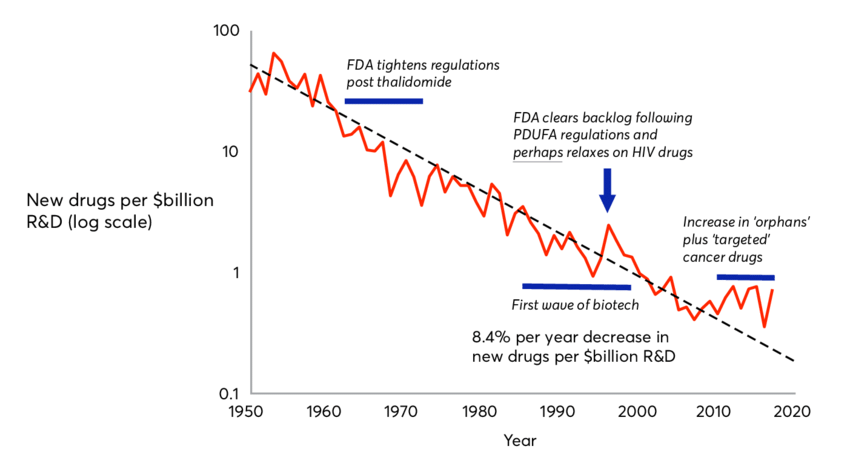The Power of Data-Driven Decision Making

People often make decisions by relying on intuition, which at times leads to costly mistakes. Read this post to understand how to overcome this very human flaw through data-driven decision making.
A common advice in decision making is to embrace gut feelings, and leaders are often lauded on their ability to quickly evaluate situations and to spontaneously act. The notion of embracing gut feelings is deeply ingrained in Western culture, with Greek philosophers promoting intuition and experience as the foundation of reasoning. The creative benefits of intuition are evident, but does gut feeling truly lead to successful outcomes?
The famous Moore’s law predicted correctly that the cost of computers would decrease steadily as years go by. A recent publication has shown that an inverse trend, dubbed Eroom’s law, applies for the rising costs the R&D process in the pharmaceutical industry. As shown in the figure below, the number of new drugs produced per $ billion investment in R&D has been consistently decreasing since the 1950s.

Figure 1. Visualization of Eroom’s law, showing the decreasing number of new drugs produced over the years per $ billion investment.
Reproduced from original source – review here.
The Very Real Cost of Uncertainty
The drug development process in the pharmaceutical industry provides a concrete example of the opportunity cost of intuitive decision making. Many pharmaceutical companies decide in a meeting room which candidates should receive further investment, after consulting PowerPoint presentations and reports. This strategy is hit and miss at best, with only one in 10 drug candidates ultimately being approved by regulatory agencies. The financial impact of these missteps is massive, with billions of dollars poured into the development of compounds that turn out to be ineffective. As an example, a drug candidate designed to treat Alzheimer’s, developed by the pharmaceutical company Biogen, recently failed the approval process by the federal drug administration (FDA), resulting in a loss of $18 billion. Advances in data-driven decision making, empowered by deep learning techniques, enable companies to analyze the failures and successes of the past and to select better leads in the future.
Putting Data in the Driver’s Seat
Foreseeing the outcome of decisions, such as the success of chosen drug candidates, is incredibly complex, and it is clear that intuition alone is a poor predictor of success. The solution to overcome this human flaw is to leverage as much data as possible during the decision making process. Data-driven decisions are less likely to be influenced by human biases, such as previous experiences, emotions, and mental states, and thus have a higher rate of success. In the case of the pharmaceutical industry, a move towards data-driven decision making involves relying on more detailed clinical trial data, using cutting-edge computational techniques to model the behavior of compounds. The goal is to make decisions that are heavily informed by patterns observed in the data.
Supporting a Data-Driven Strategy
Organizations can reap the benefits of a data-driven strategy by adopting a number of key principles, including the following crucial points.
Foster a Data Culture
A crucial step in supporting a data-driven strategy is making sure that teams are on board with this mindset shift. While some team members may not be completely aware of the importance of data in day-to-day operations, surveys show that the development of a data-driven culture is one of the top priorities for many companies. Organizations can encourage the establishment of a data-driven culture by ensuring that lines of communication remain open between data scientists and the rest of the business, thus connecting data and decision making.
Establish Data-Driven Indicators
To show the benefits of putting data at the center of the organization, it is important to develop data-driven key performance indicators (KPIs). These are measures that track the success of an organization’s strategy, revealing what works and what needs improvement. Examples of data-driven KPIs include sales by region, which shows the most promising locations for business, and transportation costs, which highlights logistical aspects that could be optimized. Each organization must select KPIs that are useful within their particular context, but the point is to leverage data in order to make informed business decisions.
Build a Data Foundation
On a technology level, a data-driven strategy is supported by the adoption of tools that capture, standardize, and store large amounts of data. The ideal choice is a solution that is capable of taking in all of the data from an organization, structuring this information and making it available for further analysis. If data is easy to work with, a business can quickly uncover valuable insights. ZONTAL offers a digital laboratory that accomplishes just that, providing powerful ways of consuming, managing, and analyzing data.
An Intelligent Use of Data
In addition to enabling informed decisions, a company with a solid data-driven strategy offers another perk. Namely, by having abundant, high-quality data, an organization becomes automatically AI-enabled. In turn, the use of approaches such as machine learning, natural language processing, and computer vision can reduce costs considerably. In the pharmaceutical industry, for example, AI can extensively assist with R&D, potentially saving billions a year. Data undoubtedly trumps intuition, and it should be the top priority of any company that wishes to remain competitive. What is more your data needs to securely preserved and accessible for reuse and sharing with your wider team This is why we have developed a dedicated Electronic Laboratory Notebook backup solution and life science data preservation platform to allow you to run a data centric lab in confidence. Read our whitepaper on data centricity to learn more about leveraging your information assets, and feel free to contact our experts anytime for additional recommendations.
Take the Next Step Toward Data-Driven Success
 >
> 

